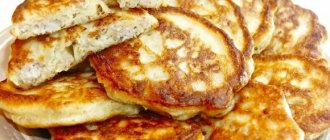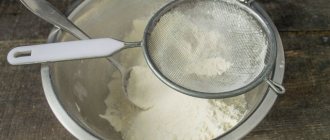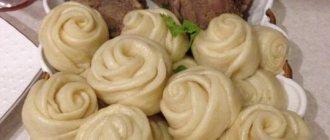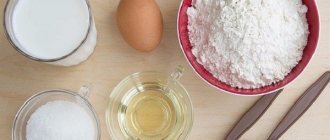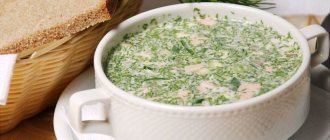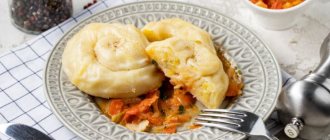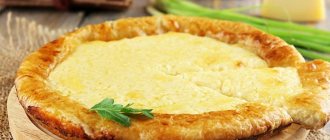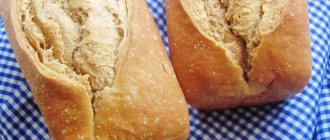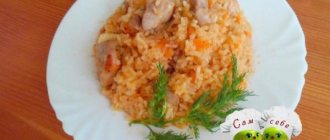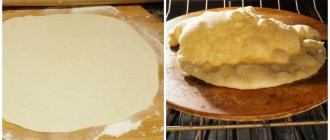Khinkal is the most famous dish of national cuisine outside of Dagestan. A festive feast cannot be complete without it; dear guests are greeted with it; if the bride has prepared a delicious khinkal for the groom’s friends, there will be harmony and happiness in the family. Let’s make a reservation right away: Dagestan khinkal has nothing to do with Georgian khinkali. The dishes are not similar either in appearance or in preparation technology, but the composition of the products is familiar to mountain residents - meat, flour, water. We will tell you about the recipe for the most unusual, beautiful and incredibly tasty dish - puff khinkal.
Dagestan khinkal made from puff pastry
Even a novice cook can prepare the food; it does not require any special skills. We offer several recipes for puff khinkal.
A good piece of meat is only half the battle. The original version uses lamb or veal, but chicken is also perfect.
Place the washed and freed meat in a whole piece (weighing about a kilogram) into a pan with cold water, add water to cover completely, and place on high heat. As soon as it boils, you need to remove the foam and reduce the heat. When boiling too high, the broth becomes cloudy and unappetizing in appearance.
Before adding meat, some housewives recommend cutting it into 5-6 pieces and frying it in a hot frying pan. A golden brown crust will appear on the meat, which will seal in all the juices. When ready, it will turn out very juicy, but will not give anything away to the broth.
To give the broth a golden color, put a peeled onion and one medium-sized peeled carrot into a pan; you can cut it into thick circles. The meat will be softer if you add salt at the end. A bay leaf and a few peppercorns will add a pleasant aroma to the dish. Chicken broth has a rich taste and such a pleasant smell that you don’t need to fill it with spices. Cover the pan with a lid and, without wasting time, start preparing the dough.
Puff pastry
For khinkal, yeast puff pastry is prepared. The more layers in the dough, the airier and tastier the baked goods. We don’t plan to bake anything, but the tender dough, well saturated with the taste of the meat broth, is just what we need.
Dissolve 1 tablespoon of dry yeast in a glass of warm, but not hot, water. Add 2 tbsp sugar and 1 tsp salt. Leave in a warm place for 15 minutes. As soon as the yeast has started its work, add 3 tablespoons of vegetable oil to the dough and begin kneading. To make the flour light and saturated with air, you must first sift it through a sieve, colander or a special mug with a lever. Our recipe will require about 400 g of flour. This is about two glasses. When kneading, it will become clear whether you need to add.
Knead the dough well, sprinkle with flour, cover with a towel to prevent it from drying out, and leave to rise in a warm place for half an hour.
Now comes the most crucial moment - turning regular yeast dough into puff pastry. First grate half a stick of frozen butter on a coarse grater. For convenience, divide the dough into 4 parts. Roll each one out thinly and spread a quarter of the butter evenly, fold in half, and then again. You will get a layer folded in four. Roll out and fold three times. Do the same with the remaining parts.
Secrets and crucial moment in preparing Avar khinkal
As soon as the dough is ready, you need to remove the meat and add boiling water and salt. Next, the broth is cooked over high heat, wait until the water boils and throw the khinkal into the boiling broth. A crucial moment in preparation: do not skip cooking the dough. The donuts that are placed in the boiling broth are timed and cooked for about 3-4 minutes. Close the lid of the pan after mixing the chopped pieces of dough. The secret and trick of the Avar khinkal is that when the boiled diamonds are pulled out, you need to quickly pierce them with a toothpick or some kind of stick - each khinkal, so that the cooked crumpets release the air and remain as fluffy as they were when cooking, see how this is done in our video recipe:
?t=17m42s, otherwise khinkal won’t work!
How to understand that Avar khinkal is ready? We will see that it rises from the broth, but to be absolutely sure, we need to test it personally, and then very quickly pull it out of the broth. If it is overcooked, it becomes gray in color and very thin. They say that if the khinkal is ready, it bounces on the colander like a ball or hangs on a toothpick.
Cooking khinkali can be divided into two parts by placing one portion into the boiling broth at the beginning, and then the other.
Recipe 1
After removing the finished meat from the broth, send the snails from the dough there, first pinching the edges so that they do not unfold. Take your time and cook in several stages; sticky khinkaliki look ugly, and they don’t taste the same.
If the meat cools down while you cook the khinkal, reheating it only takes a few minutes. Place the khinkal on a plate, sprinkle with herbs.
Khinkal / Cuisine of Dagestan
Khinkal is the pride of the mountain people; it is prepared absolutely everywhere in Dagestan. Do not confuse with Georgian khinkali! This is a completely different, complex dish. Khinkal is served as a first and second course at the same time, prepared at any time of the day for family and guests, for all occasions.
Khinkal is not even a dish, but a whole complex of dishes consumed simultaneously. These are pieces of dough boiled in broth, slightly different in recipe and shape in each place, which are eaten, dipped in sauce, with lamb or beef (sometimes with chicken) and washed down with a strong meat broth with spices. Sauces always go with khinkal. Most often it is sour cream or kefir with garlic and herbs. Spicy tomato sauce is also a favorite...
Recipe 2
The cooked meat, removed from the broth, is divided into portions and fried in a frying pan with grated carrots and onion cut into rings.
Several large potatoes are peeled and cut into 4-6 pieces lengthwise. The khinkal ingredients are placed in a pan in layers. First potatoes, meat and vegetables on top, and then prepared dough rolls. Pour in the broth so that the dough is not completely covered with liquid, and put on low heat until the potatoes are ready. In this version, the dough will be cooked both in broth and steamed. All components will be saturated, give each other their taste and fill with aroma.
The dish is served hot and always with sauce. Bon appetit!
Dargin Miracle! This is the national dish of Dagestan cuisine.
Very tasty, satisfying and easy to prepare. You will need for the dough: 1 kg of flour, 1 tbsp. salt, water for filling: 600-700 grams of ground beef or lamb, 250-300 grams of onions, 1 kg of potatoes, salt and pepper to taste. And also butter for lubrication. From the specified amount of products you will get approximately 4 miracles!
Preparation: Knead the unleavened dough. It should be soft, much softer than dumplings. You can also use yeast dough to prepare miracles, then they will turn out softer and more fluffy, but for me personally. my relatives and friends really like miracles made from unleavened dough, as they turn out thinner and, if served immediately. crispy. So…
Step-by-step recipe with photos
I am a big fan and admirer of oriental cuisine. Although it is always high in calories, it is incredibly appetizing.
Today I want to share with you a recipe for making khinkal and not just khinkal, but puff pastry. Here it is - the perfect side dish for meat or vegetables!
Several eastern peoples attribute khinkal to their traditional cuisine. The lucky ones - they have been eating such yummy food since childhood!
Particularly tasty is layered khinkal with meat, which we will now deal with.
Ideally it should be either beef or lamb. Cut the meat into fairly large pieces, but not too large, so that they can be easily handled during the meal.
Onions are an indispensable product in oriental cuisine. The more onions, the tastier. Cut it into strips; when cooked it will be very soft, but the taste of the dish will be fantastic.
It is better to cut carrots for khinkal into large pieces: into disks, like mine, or into large strips.
If you have a cauldron, then there is absolutely no need to fry the meat in a frying pan, like I do. Do everything at once in the cauldron and you'll avoid an extra step and another dirty pan.
At the time I was cooking, the cauldron was busy, so I prepared the soup sauce in a saucepan and frying pan.
Do you want to know how to cook khinkal? Then we go to you!
Greetings, dear readers of the blog “Dances of the Peoples of the Caucasus”. Today I want to please you with a recipe for one of the most common and famous dishes of Caucasian cuisine. As you already understood, this is khinkal . I have heard so many interesting legends and traditions about my favorite khinkal that this circumstance only fuels my interest in it.
For example, one of the traditions says that a young bride on her wedding night should prepare khinkal for all the groom’s friends. If everyone likes the prepared dish, it means that the young people will have a long and happy life. They say that some Caucasian guys seriously “force” their wives to cook khinkal on their wedding night.
There are hundreds of jokes circulating among people that once again prove the importance of this dish for Caucasians. To be more precise, for the peoples of Dagestan. Since it was here that khinkal became most widespread. By the way, here's an anecdote from Wikipedia:
They sent the Avar to the “Field of Miracles”.
Leonid Yakubovich reads the task: “You see a six-letter word. This is what a person first needs for life. If there is no “this”, then a person simply will not be able to live. I'll give you a hint - there is an "X" in the word.
Here the Avar says: “I’m ready to name the word - this is khinkal. A person cannot live without it.”
And here is the second anecdote, which I already told you in the article “Secrets of the wild popularity of Caucasian cuisine”:
A resident of Dagestan decided to go to a cafe and eat. He comes in, sits down at the table and the waitress comes up: “Hello, what do you want?”
That one: “Khinkal!”
She: “Which one – Dargin, Avar, Lak, Kumyk or Azerbaijani?”
The visitor is furious: “What difference does it make? I won’t talk to him.”
Khinkal - varieties and necessary products
Dagestan khinkal is the most popular dish in the North Caucasus. After all, it was not for nothing that the waitress from the joke specified which khinkal to bring. I have always been amazed by the simplicity of its preparation. But, believe me, behind the obvious simplicity there is a special ritual, the violation of which will immediately ruin your dish. I know girls who simply cannot cook it. It’s not that they don’t want to, on the contrary, they have a great desire, they study, but it doesn’t work out for them. Sometimes they overcook, sometimes they roll out the dough incorrectly, sometimes they over-salt it.
Why do you think khinkal has gained such popularity? Most likely, due to the ease of preparation and the relative availability of the necessary products. By the way, under no circumstances should Dagestan khinkal with Georgian khinkali. These are completely different dishes. If we talk about varieties of khinkal, there are just a bunch of them. There are as many species as there are peoples. But let’s list the most famous and probably the most delicious (by the way, I haven’t eaten all of them):
- Avar
- Darginsky
- Laksky
- Kumyk
- Lezginsky
- Azerbaijani Khingal (note, exactly KhinGal)
- Chabansky (I’ll tell you below why it’s called that)
- Thin (Derbent)
Of course, there are some similarities in all these dishes, but basically they are completely different. In the future we will tell you about each of them. Subscribe to blog updates to receive all new recipes in your email. By the way, when I was listing the varieties of khinkal, I remembered that Caucasian dances could be listed in the same way.
By the way, shepherd khinkal received such an interesting name from the fact that shepherds (shepherds) in Dagestan usually go to the pastures for several days to feed their flock. Of course, the most appetizing, satisfying and easy-to-prepare dish in nature is khinkal . It is logical that they do not take with them a board and a gurney for rolling out dough. Instead, the dough is rolled into small sausages (you could see this in the video above) and small pieces are torn off, which are thrown into the cauldron.
My wife and I decided to prepare thin (Derbent) khinkal, which is most common in the south of the Republic of Dagestan. Actually, Tabasarans, Lezgins, Azerbaijanis and other Caucasian peoples living in these places prepare approximately the same thing. I think it’s clear why this khinkal is also called Derbent. If not, then I can make a clarification: Derbent is considered the unofficial capital of Southern Dagestan.
Let me give you a list of all the necessary products, and then let’s move on to the cooking process itself. By the way, we will cook for 4 people:
- Meat – 400 grams. They use lamb or beef, or you can do both.
- Chicken – for 4 people, half a chicken is often used. In addition to meat, we will also need broth. Although, you can do without chicken. Below I will tell you how this is done. By the way, if you haven’t eaten khinkal cooked with turkey, consider that you haven’t eaten anything. It is with turkey broth that the most delicious and aromatic khinkal is obtained.
- Flour - how much will go. Yes, it is impossible to give here in grams. Just know that you want a stiff dough. Below you will find out why it should be tight.
- Ghee butter – 150 ml
- Water – 120 ml (half a regular 250 ml glass)
- Egg – 1 pc.
- Potatoes – 1 pc. Although, you can do it without potatoes, we just decided to use it because the dish turns out tastier.
- Onion – 1 head
- Salt
Have you written everything down? Then let's move on...
A guide for those who want to learn how to cook Dagestan khinkal
To be honest, it should be noted that people have very different attitudes towards this dish. Of course, the vast majority of Caucasian girls and guys simply adore him. I am one of them, although my wife doesn’t eat it at all. But I noticed an interesting pattern - all those who try khinkal speak in excellent terms and epithets. Be that as it may, I think it will not be superfluous for you if you learn how to cook everyone’s favorite dish.
Before asking the question “how to cook Dagestan khinkal?” , you need to understand that preparing khinkal includes three stages:
- Preparing and cooking meat
- Preparation of the “khinkalins” themselves
- Preparing the sauce (gravy)
I think that my wife (despite the fact that she doesn’t eat khinkal at all) will tell me better than me what goes where and why. Moreover, she has experience, the article “How to cook pilaf if you have never done it before” is proof of this. So, I give her the floor...
The first stage begins with the fact that we boil the chicken in salted water, then strain the broth (as mentioned above, it will be useful to us) and set our chicken aside. While the chicken is cooking, you need to grind the meat and onions in a meat grinder. Mix them, add salt and get minced meat (see the picture above). Steam the resulting minced meat in a frying pan, adding a small amount of water. Yes, be sure to cover with a lid, otherwise the water may evaporate very quickly.
After the meat has been steamed (it should be almost ready), add about 100 ml of melted butter to the same frying pan and fry over medium heat:
By this time the chicken should already be cooked. You and I, as I wrote above, have strained the broth and are proceeding to the second stage of preparing khinkal. First of all, you need to knead the dough, and it should be “tight” to make cutting easier.
After this, roll out the resulting dough so that it is approximately 2 mm thick. By the way, pay attention to the fact that you need to roll it out with a special long gurney. We call it “ohlov”:
This is where you need the dough to be “tight”, since soft dough is very difficult to cut. If your dough still turns out soft, then it will be enough to wait a little until it dries a little. Yes, before we start cutting, you need to sprinkle the resulting dough with flour:
Khinkal can be cut into cubes or diamonds. We always cut into cubes, and you choose. After the “khinkalins” are ready, we need to boil the chicken broth. By the way, you can heat the broth in advance so you can immediately start cooking the khinkal. Yes, it doesn't have to be chicken broth. There are people who cook in water, to which they add a little flour and butter in advance. But it’s better to cook it in chicken broth, it’s much tastier and more aromatic.
While the broth is heating, chop the potatoes. Yes, and this is also optional. There are just people who like to experiment. We are one of those people, especially since it tastes better with potatoes.
As soon as the broth boils, first of all, put the chopped potatoes into the pan. After about 5 minutes, when the potatoes are almost ready, put the khinkalina into the pan.
It is very important that our khinkal is not overcooked. In general, it cooks very quickly, about 4-6 minutes. But, it’s better to try khinkalina from time to time to see if it’s ready. While everything is cooking, you need to heat the remaining 50 ml of oil and prepare the sauce (gravy). And here everything depends on your imagination and flight of thoughts. You can cook what you like. For example, you can make tomato sauce, sour cream with garlic, vinegar with garlic, urub (made from sour plum). In this situation, we took the path of least resistance and used squeezed garlic in vinegar:
By this time, our khinkal has already been cooked and is almost ready. Using a colander-spoon (skimmer), we remove the khinkalins along with the potatoes from the pan and place them on a separate plate for each person. After this, pour warmed oil over the khinkal:
Place the meat on the same plate (do not forget to warm it up, as it may cool down). In principle, this is where the preparation of khinkal . Broth and chicken are served on the table with it. To make the broth even more flavorful, add a spoonful of butter and meat to it. Yes, and don’t forget about our garlic and vinegar.
Khinkal should be eaten immediately, as it may stick together. Well, how do you like our dish today? Are you drooling? Be sure to try it and write in the comments how it turned out. Let's discuss it together. Yes, I'm wondering how you cook everyone's favorite dish? Maybe you have some secrets of your own?
I end here and remind you that my wife and I will continue to delight you with the most delicious Caucasian dishes. Become a regular reader of the blog to receive all recipes and new articles by email (how to become a reader?). Yes, and a little news - very soon I will post an interview with a very interesting person on my blog. Believe me, many of you will be pleasantly surprised.
Friends, I will be glad to read your opinion in the comments.
Sincerely, Tuta Akhundova and Ali Askerov!
This is interesting:
- Azerbaijanis: history and modernity of the Caucasian people
- ...Competitions
- ...Why did I ignore your message?
- Holidays in the North Caucasian Federal District: funds allocated for the renovation of the Kavminvod sanatorium...
- The average salary in the North Caucasus Federal District increased by 8%
- Children of mountain villages of Dagestan will be taught robotics
Recipe for “Layered khinkal”:
Boil a kilogram of coarsely chopped lamb with a whole onion. Cook the lamb for a long time over low heat. Do not let the broth boil too much so that it is clear. If there is no lamb, I make it from chicken (very practical, there are no strictly specified ingredients) Use your imagination)))
While the meat is boiling, knead the dough for khinkal. We dilute 2 teaspoons of dry yeast in 250 ml of warm milk (or water). In a deep bowl, mix the sifted flour and salt and make a well in the middle. Pour our milk and yeast into the well, mix everything well. At the very end, add 3 tbsp. spoons of vegetable oil. Mix everything well again. Let stand for 15 minutes so that the dough rises a little.
Roll out the dough thinly (first sprinkle the table and rolling pin with flour), grease with melted butter.
Sprinkle with chopped walnuts.
Here we are in action, the steamer is getting ready to take our khinkal))
Roll the dough into a roll. Cut into pieces approximately 2-3 cm in size.
Grease the sheets of the manty cooker with butter, place the khinkal on the sheet. Cook for a couple of minutes for 40 minutes. You get crumpets with a nutty taste.
Cooking steps
- Let's prepare all the necessary ingredients for the meat component of our Avar khinkali.
We thoroughly wash the leg of lamb, dry it and chop it into about three large pieces. Pour 5 liters of cold water into a deep, large saucepan, add salt to taste, and put on fire. Place pieces of meat in a pan, add washed cilantro stems and one head of peeled onion. Add the specified number of peppercorns and juniper berries to the meat. Leave the broth and meat to cook over medium heat.
During this time, we will prepare the dough for khinkali. Pour all the prepared kefir and soda into a deep bowl, then begin to pour in the flour portionwise and immediately knead the dough. Mix the ingredients until the dough has a homogeneous structure: we should get a mass that is quite plastic to the touch. Cover the bowl with the dough with a towel or cling film and set aside to infuse.
We wash the entire specified number of tomatoes and remove the thick skin, then rub them into a deep bowl. Peel the garlic cloves and squeeze half of them through a press into the tomatoes. Mix the ingredients thoroughly, add salt and ground red pepper to taste. Chop the remaining half of the garlic cloves, pour into a saucepan and add two tablespoons of cold water.
Heat a piece of butter in a frying pan with a thick bottom.
Pour the mixture of tomatoes and garlic into the frying pan with the butter, stir thoroughly.
Simmer the ingredients over medium heat for 30 minutes until half of the liquid has evaporated.
We chop all the greens we have and add most of them to the sauce, mix the ingredients in a frying pan, and continue to simmer for another 10 minutes. Pour the prepared sauce into the garlic soaked in a saucepan, mix and set aside.
Let's form khinkali. To do this, we divide the resulting dough into several equal parts: this will make it easier to work with. Roll out each part into a thick layer: its height should be approximately 1 centimeter. We cut the layer diagonally so that we get diamonds (see photo).
During this time, the broth and meat were sufficiently cooked. Remove the meat with a slotted spoon and transfer it to a separate pan. Strain the broth and return to the heat, add liquid if necessary and bring to a boil. Cook khinkali in portions in meat broth until they float, drown them in liquid and repeat this procedure at least 3 times. Place the finished khinkali on a dry, clean plate and pierce each diamond with a fork immediately.
We set the table as follows: put the khinkali on a separate dish and pour it generously with the prepared tomato sauce, place the cooked meat next to it, which needs to be torn into small pieces and sprinkled with the remaining herbs, and also put a bowl of broth on the table.
Now you know how to properly prepare Avar khinkali.
Bon appetit!
Alexander Gushchin
I can’t vouch for the taste, but it will be hot :)
Content
Avar khinkal is often confused with another similar dish, “Georgian khinkali”. The luxurious treat consists of aromatic boiled meat, airy flat cakes made from fluffy dough, sauce and rich meat broth. The dish is served in beautiful dishes and decorated with plenty of fresh herbs.
